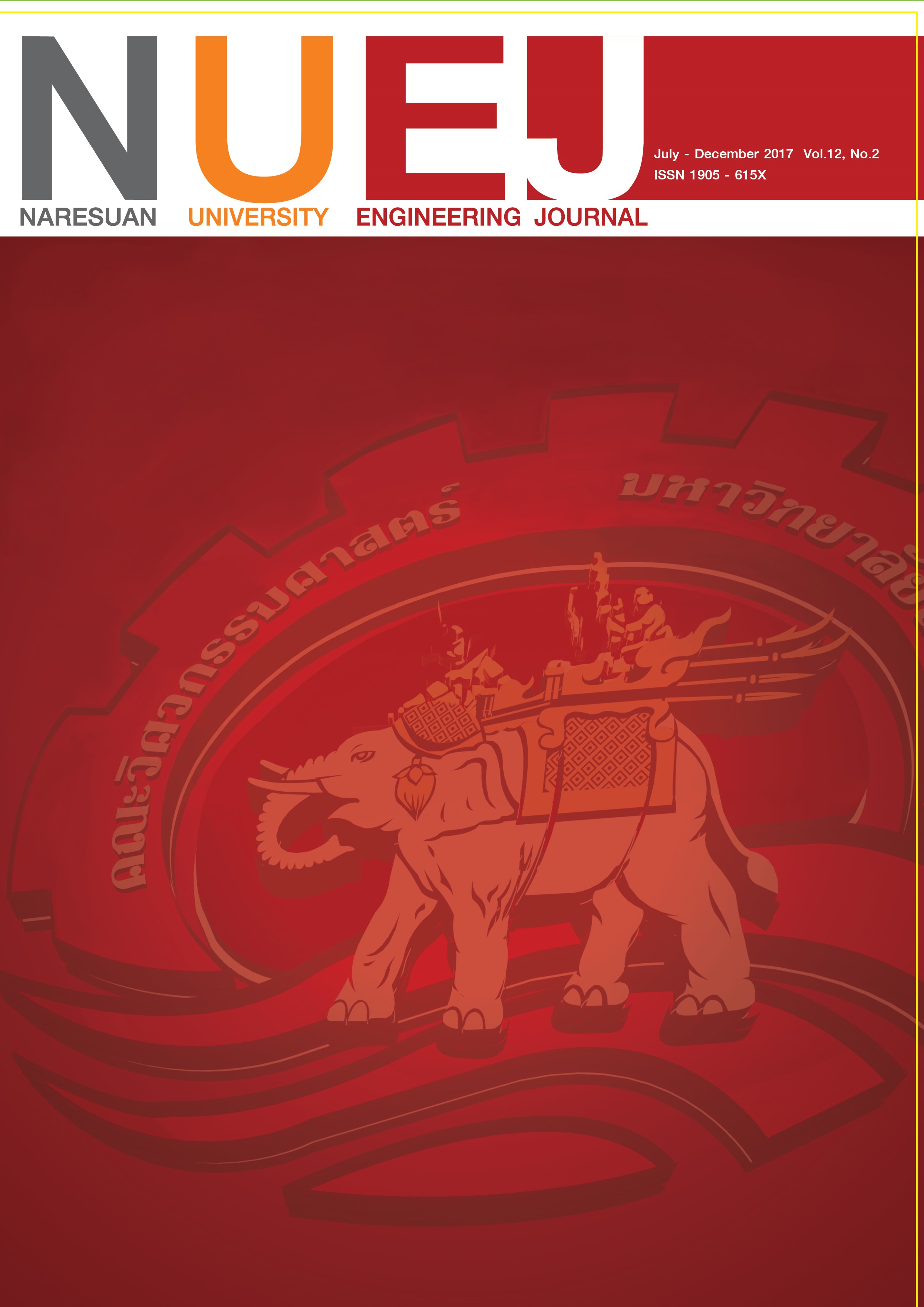การพัฒนาการขึ้นรูปโครงเลี้ยงเซลล์เพื่องานวิศวกรรมเนื้อเยื่อผิวหนังด้วยเทคนิคการหล่อแบบเทปจากเจลาติน ไฟโบรอิน และไคโตซาน Development of Fabrication of Gelatin-Fibroin-Chitosan Scaffold for Skin Tissue Engineering Using Tape Casting Technique
Main Article Content
Abstract
The objective of this research was to fabricate scaffold for skin tissue engineering using tape casting technique, which were suitable for fabricate skin scaffold, which can control the thickness of the specimen. Experimental design based on mixture design was employed to determine suitable compositions which were able to tape cast and effects of components on water swelling of the scaffolds, consisting of gelatin, fibroin, and chitosan. From prelimary study, it was found that the slurry compositions with fibroin less than 40% had a tape castibility. According to the 7 compositions selected, the tapes were smooth and had uniform thickness. The average swelling ability of sample was 613.10-774.73%, it was found that the slurry components in scaffold significantly contribute to water swelling and It is also biocompatible because the cell survival rate was over 80 percent in 24 hours. These properties of the experiment samples are suitable for application of skin tissue engineering.
Article Details
References
ธนา เชื้อบัณฑิต. Advance Skin Replacement. กลุ่มงานศัลยศาสตร์ โรงพยาบาลศูนย์ขอนแก่น, 2556.
วรเดช พิชัยอุตกฤษฏ์, วิริยา จูวัฒนสาราญ, ธีระศักดิ์ ดารงรุ่งเรือง. ผลของสารที่ทาให้เกิดรูพรุนต่อสมบัติทางกายภาพของโครงเลี้ยงเซลล์สามมิติไฟโบรอินจากไหมไทยสายพันธุ์ผสมนางน้อยศรีสะเกษ 1 และ ม. การประชุมวิชาการระดับชาติ มหาวิทยาลัยรังสิต, 2558.
Agarwala, T., Narayana, R., Majia, S., Beheraa, S., Kulanthaivelb, S., Maitia, T.K., Banerjeeb, I., Palb, K., Giric, S. 2016. “Gelatin/Carboxymethyl chitosan based scaffolds for dermal tissueengineering applications”. International Journal of Biological Macromolecules.
Bhardwaj, N., Kundu, S.C. 2011. “Silk fibroin protein and chitosan polyelectrolyte complex porous scaffolds for tissue engineering applications”. Carbohydrate Polymers 85, 325–333.
Liu, H., Mao, J., Yao, K., Yang, G., Cui, L., Cao, Y. 2004. “A study on a chitosan-gelatin-hyaluronic acid scaffold as artificial skin in vitro and its tissue engineering applications”. Journal of Biomaterials Science, Polymer Edition 15, 25–40.
อธิตญา อุ่นใจ. การพัฒนาวัสดุทดแทนกระดูกชนิดเนื้อพรุนด้วยวิธีทำให้แห้งแบบเยือกแข็ง. วิทยานิพนธ์วิศวกรรมศาสตรมหาบัณฑิต วิศวกรรมศาสตรมหาบัณฑิต สาขาวิศวกรรมอุตสาหการ มหาวิทยาลัยเชียงใหม่, 2559.
Hong, S.R., Lee, S.J., Shim, J.W., Choi, Y.S., Lee, Y.M., Song, K.W., Park, M.H., Nam, Y.S., Lee, S.I. 2001. “Study on gelatin-containing artificial skin IV: a comparative study on the effect of antibiotic and EGF on cell proliferation during epidermal healing”. Biomaterials 22, 2777-2783.
Ong-chiari, W., Srisuwan, Y., Simcheur, W., Srihanam, P. 2009. “Morphology, Secondary Structure and Thermal Properties of Silk Fibroin/Gelatin Blend Film”. Pakistan Journal of Biological Sciences 12 (23), 1526-1530.
ชัญญาพัทธ์ ขำเกษม. การหาสภาวะที่เหมาะที่สุดของการขึ้นรูปวัสดุไฮดรอกซีอะพาไทต์โดยใช้เทคนิคการหล่อขึ้นรูปแบบเทป. วิทยานิพนธ์วิศวกรรมศาสตรมหาบัณฑิต สาขาวิชาวิศวกรรมอุตสาหการ มหาวิทยาลัยเชียงใหม่, 2556.
Tarun, A., Rajan, N., Somnath, M., Shubhanath, B., Senthilguru, K., Tapas, K.M., Indranil B., Kunal, P., Supratim, Giric. 2016. “Gelatin/Carboxymethyl chitosan based scaffolds for dermal tissue engineering applications”. International Journal of Biological Macro-
molecules.
สุวิชญา ปันทะวัง และ วัสสนัย วรรธนัจฉริยา. การผลิตและทดสอบคุณลักษณะโครงสร้างเลี้ยงเซลล์แบบรูพรุนเพื่อการทดแทนผิวหนัง. การประชุมวิชาการข่ายงานวิศวกรรมอุตสาหการ ภาควิชาวิศวกรรมอุตสาหการ คณะวิศวกรรมศาสตร์ มหาวิทยาลัย
ขอนแก่น, 2559.
Sun, H.W., Feigal, R.J., Messer, H.H. 1990. “Cytotoxicity of glutaraldehyde and formaldehyde in relation to time of exposure and concentration” Pediatric dentist 12, 303-307.
Wattanutchariya, W., Changkowchai, W. 2014. “Characterization of Porous Scaffold from Chitosan-Gelatin/Hydroxyapatite for Bone Grafting”. Engineers and Computer Scientists.
ASTM F 895-11. Standard test method for agar diffusion cell culture screening for cytotoxicity. Pennsylvania: American Society for Testing and Materials (ASTM); 2011.
Adalı, T., and Uncu, M. 2016. “Silk fibroin as a non-thrombogenic biomaterial”. International Journal of Biological Macromolecules.

